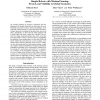Free Online Productivity Tools
i2Speak
i2Symbol
i2OCR
iTex2Img
iWeb2Print
iWeb2Shot
i2Type
iPdf2Split
iPdf2Merge
i2Bopomofo
i2Arabic
i2Style
i2Image
i2PDF
iLatex2Rtf
Sci2ools
100
click to vote
AAAI
2007
2007
Simple Robots with Minimal Sensing: From Local Visibility to Global Geometry
We consider problems of geometric exploration and selfdeployment for simple robots that can only sense the combinatorial (non-metric) features of their surroundings. Even with such a limited sensing, we show that robots can achieve complex geometric reasoning and perform many non-trivial tasks. Specifically, we show that one robot equipped with a single pebble can decide whether the workspace environment is a simply-connected polygon and, if not, it can also count the number of holes in the environment. Highlighting the subtleties of our sensing model, we show that a robot can decide whether the environment is a convex polygon, yet it cannot resolve whether a particular vertex is convex. Finally, we show that using such local and minimal sensing, a robot can compute a proper triangulation of a polygon, and that the triangulation algorithm can be implemented collaboratively by a group of m such robots, each with Θ(n/m) memory. As a corollary of the triangulation algorithm, we derive ...
Related Content
| Added | 02 Oct 2010 |
| Updated | 02 Oct 2010 |
| Type | Conference |
| Year | 2007 |
| Where | AAAI |
| Authors | Subhash Suri, Elias Vicari, Peter Widmayer |
Comments (0)

